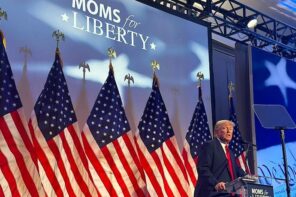In the wake of Donald Trump’s election (and since) many tried to answer the question, “Why would evangelicals support him?” According to the Pew Research Center 81 percent of white evangelicals voted for Donald Trump, an astonishing margin given Trump’s lack of church involvement and his, um, complicated personal history. But few solid analyses have come from within the movement itself. Instead, most pundits have either treated evangelicalism as an oddity or revealed their own personal alienation from the movement.

Believe Me: The Evangelical Road to Donald Trump
John Fea
Eerdmans
June 30, 2018
Fea is an insider who teaches at an evangelical college and attends an evangelical megachurch. When he describes the experience of walking into his church the Sunday after the 2016 election, surmising that most of his fellow believers had voted for a horrible person like Donald Trump, I feel his pain.
Fea begins by setting forth the obvious reasons one might expect evangelicals to reject Donald Trump. Trump’s faults extend beyond personal moral failings and “virtually no evidence of a Spirit-filled life.” Other Republican candidates shared conservative policy values, and with greater consistency than Trump, and possessed far more compelling spiritual bona fides. Yet before Trump defeated Hilary Clinton, he defeated those conservative Christian candidates. White evangelicals still support Trump.
Fea walks a fine line between empathy for his fellow evangelicals and critical appraisal. He believes evangelicals hold legitimate grievances against Democrats. He explains that during the Obama administration evangelicals experienced setbacks at a dizzying pace, particularly with respect to matters of gender and sexuality. Obama’s stance on abortion could be taken as a given, but his change of mind on same-sex marriage—if it was indeed a change of mind—was an unwelcome surprise. Fea perceives attacks on religious liberty in the Affordable Care Act’s requirements concerning birth control and the Obama Justice Department’s enforcement of civil rights for LGBT persons. All of these factors motivated evangelicals to believe that they and their movement were under siege.
But evangelicals will also feel Fea’s sting. In Fea’s analysis, three tropes—fear, nostalgia, and power—primarily account for Trump’s appeal to evangelicals. A sense of cultural disorientation tinged with racism plays into the long-standing conservative strategy—the appeal to fear, nurtured by Trump more effectively than any other candidate. If evangelicals disagreed with his policies, “Obama’s biracialism, single-parent upbringing, and global experiences made him a poster child for the demographic changes taking place in the country.” Fea’s chapter, “A Short History of Evangelical Fear,” is worth the price of the book.
Evangelicals long for a mythical Christian past, and Trump’s “Make America Great Again” mantra appeals directly to that troubled nostalgia. But Fea presses, “Christians should be very careful when they long for the days when America was apparently ‘great.’” Are we appealing to the post-war boom in church attendance, which occurred with Jim Crow in force and when marital rape was legal? And by embracing prominent evangelical leaders, whom Fea labels “court evangelicals,” Trump assuages evangelicals’ gaping wound—disenfranchisement—by granting them access to power. Readers will come away with a nuanced appreciation for fear, nostalgia, and power as fundamental elements of evangelical discourse.
But there are other ways to tell the story. Fea repeatedly calls Trump a “strongman,” suggesting the threat of authoritarianism. Perhaps Fea could have more directly tied Trump’s appeal to evangelicalism’s prominent authoritarian streak as part of a global erosion of participatory democracy. He comes close to doing so by telling the story of evangelical fear—including emerging responses to immigration, and by assessing the movement’s longing for power—but Fea stops short of saying that evangelicalism has long had a problem with authoritarianism and alternative facts.
The question of race figures prominently in Fea’s analysis, but it does not rise to the level of the Big Three: fear, nostalgia, and power. I weigh racism as a larger contributor in white evangelical Trumpism. Our respective backgrounds may account for our differences on this point. I grew up in the South; Fea did not. Perhaps historians need to take greater account of the divergent histories within evangelicalism.
Fea repeatedly notes evangelicals’ mixed (at best) history with respect to race relations. He devotes nine pages to the history of racial fear in the evangelical South, but he never gets messy with the most telling factor: that no other religious group even remotely approaches white evangelicals’ preference for Trump. Race proved one of the most decisive predictors of Trump support, and white evangelicals were the most loyal Trump voting bloc of all.
At one point Fea flirts with a pointed analysis of racism. He discusses how the Hart-Celler Act changed immigration patterns in the United States, bringing more people of color and more non-Christians into the population than had ever come before. The Act, he argues, instilled fear in white evangelicals. Fea locates immigration in the context of evangelical fear that Christianity was losing its hold on American culture.
But the caution of his argument fails him. When he takes up the ambiguous (again, at best) engagement of evangelicals with the Civil Rights Movement, he rehearses “the relationship between race and evangelical opposition to ‘big government’ intervention in state and local affairs.” But here’s the problem: for a long period of time, evangelical resistance to activist government emerged out of resistance to civil rights. It has no other meaningful origin. Prior to the Civil Rights Movement and the Reagan Revolution, white Southerners had voted Democrat, supporting organized labor, government infrastructure programs, and investment in education. The big government argument is precisely the point at which Republicans values united with Southern racism to transform American politics.
Perspective is everything. One could rehearse a history of evangelical progressivism in the nineteenth century, with a spotlight on Charles Finney’s inclusion of women and opposition to slavery. One could call attention to the interracial outbreak of Pentecostalism at Azusa Street. But that story is highly selective. It has almost nothing to do with Southern evangelicalism.
The very term “Southern evangelicalism” poses problems. A huge chunk of what we call the evangelical movement today would have identified themselves simply as “Christians” in the South of my childhood. Our evangelical-mainline distinctions made little difference to most people. Southern Baptists were, well, Southern, and rarely identified as evangelical. Churches of Christ, a massively influential movement in parts of the South and Midwest, had little to do with other Christian groups. Southern Methodists and Presbyterians didn’t merge with their national counterparts until 1968 and 1983, respectively. Today’s Presbyterian Church in America emerged from pro-segregation Southern Presbyterians and only recently repented of its racist roots. A key question today might involve the degree to which a Southern ethos, complete with its implicit racism, shapes American evangelicalism.
This is a good and timely book. Fea is correct that evangelicals feel a sense of cultural disenfranchisement. But I do wish Fea had addressed authoritarianism and racism more directly. Polling data from 2016 reveals both as primary factors in Trump support.
Just decades ago conservative white churches constituted what amounted to cultural Christianity in the South. Before the rise of the Religious Right, they saw little common cause with Northern evangelicals. But while other evangelicals feel tension with the broader culture over religion, Southern evangelical alienation is largely about being Southern. And being Southern is all about race.





